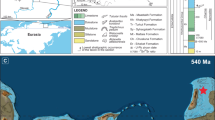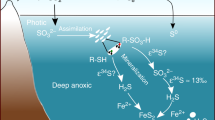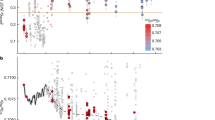Abstract
Arising from: D. A. Fike et al. Nature 444, 744–747 (2006)10.1038/nature05345; Fike et al. reply
The link between the radiation of various lineages of eukaryotes in the latest Proterozoic and massive environmental changes—oxygenation, global ice ages and bolide impact—is the focus of much research interest. Fike et al.1 use carbon and sulphur isotope–chemostratigraphic data from Oman to propose three stages of oxidation in the Ediacaran oceans, and link the second and third stages to eukaryote diversification. The second stage, signalled by strongly 13C-depleted sedimentary carbonates (the ‘Shuram excursion’), is believed to result from oxidation of a large, deep-ocean reservoir of organic carbon1. Fike et al. use our data2,3 to assert that a correlative carbon isotope excursion in Australia coincided with the initial diversification of acanthomorphic acritarchs. Peak diversity is claimed to have coincided with subsequent deposition of 13C-enriched carbonate and the third oxidation stage. However, the authors seem to have misinterpreted our data, which instead indicate that diversification significantly preceded the Shuram excursion; this weakens their argument for a link between the inferred oxidation events and eukaryote evolution.
This is a preview of subscription content, access via your institution
Access options
Subscribe to this journal
Receive 51 print issues and online access
$199.00 per year
only $3.90 per issue
Buy this article
- Purchase on Springer Link
- Instant access to full article PDF
Prices may be subject to local taxes which are calculated during checkout

Similar content being viewed by others
References
Fike, D. A., Grotzinger, J. P., Pratt, L. M. & Summons, R. E. Oxidation of the Ediacaran Ocean. Nature 444, 744–747 (2006)
Grey, K. in Ediacaran Palynology of Australia. Mem. 31 (ed. Laurie, J. R.) 1–439 (Association of Australasian Palaeontologists, Canberra, 2005)
Calver, C. R. Isotope stratigraphy of the Ediacarian (Neoproterozoic III) of the Adelaide Rift Complex, South Australia, and the overprint of water column stratification. Precambr. Res. 100, 121–150 (2000)
Willman, S., Moczydłowska, M. & Grey, K. Neoproterozoic (Ediacaran) diversification of acritarchs—a new record from the Murnaroo 1 drillcore, eastern Officer Basin, Australia. Rev. Palaeobot. Palynol. 139, 17–39 (2006)
Calver, C. R. & Lindsay, J. F. Ediacarian sequence and isotope stratigraphy of the Officer Basin, South Australia. Aust. J. Earth Sci. 45, 513–532 (1998)
Author information
Authors and Affiliations
Rights and permissions
About this article
Cite this article
Grey, K., Calver, C. Ediacaran oxidation and biotic evolution. Nature 450, E17 (2007). https://doi.org/10.1038/nature06360
Received:
Accepted:
Published:
Issue Date:
DOI: https://doi.org/10.1038/nature06360
Comments
By submitting a comment you agree to abide by our Terms and Community Guidelines. If you find something abusive or that does not comply with our terms or guidelines please flag it as inappropriate.



